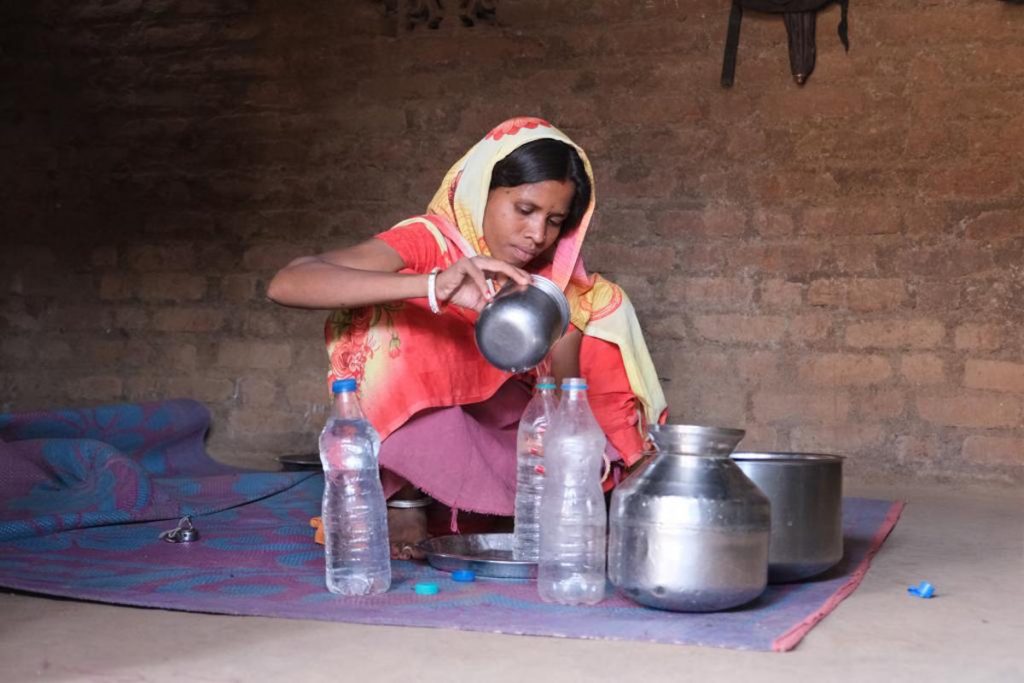
Nirmala Devi’s 9-year-old daughter, Ritu, spent two weeks in a government-run hospital last year. Her daughter was sick with typhoid and she even went into a coma for two days. Medicos said contaminated water was the primary source for her illness.
After Ritu was discharged, Devi’s main worry was her ability to obtain safe drinking water for her daughter. She was strongly advised not to consume water from village wells or untested sources such as river streams or springs around Ghutighat — her tribal village in central India’s Madhya Pradesh.
Devi works alongside her husband as a daily wage laborer, but her income is limited; she can’t even afford packaged drinking water for her daughter. She tried boiling water using firewood as fuel in order to make it safe to drink, but that proved difficult.
“To get the firewood you have to trek the treacherous terrain of nearby forests and at times the forest guards arrest you, charge you with timber smuggling,” Devi told LiCAS.news.
“You have to bribe them to save yourself from jail. The contaminated water has been making people ill in droves in our village. There was nothing we could have done about it,” she said.
An estimated 80 percent of India’s rural drinking water comes from underground sources and such water in one-third of India’s 600 districts is not fit for drinking. Overall India’s water quality is poor; the country ranks 120th among 122 nations in terms of the quality of water available to its people.
According to Dr. Shashank Shekhar, who teaches geology at Delhi University, the most common chemicals found in underground water are arsenic and fluoride which come from dumped industrial waste and nitrates from excessive fertilizers use.

In early February, a Caritas team conducted a survey on hazardous effects of contaminated water in Devi’s village. The team was guided to Devi’s house by the ‘sarpanch’ (village head).
“In the beginning, I thought it was some government agency routinely conducting a tiresome survey that in the end is of no use, but they instead talked about safe drinking water and how it could save our children from diseases,” Devi said.
Mohan Ram, who lives few yards away from Devi’s house, said the team asked a series of questions which included how often their family members fell ill due to consumption of unsafe drinking water.
“We have been fetching water from open wells and river streams for years. I have grown old now consuming this water,” Ram said.
“However, lately, our children have been developing severe water-borne diseases. We don’t know the reason, but it seems it is because of chemical fertilizers in the soil,” he said.
Father Paul Moonjely, the executive director of Caritas India, said the agency’s surveys found water in rural Madhya Pradesh state was severely affected by waterborne diseases.
“In tribal villages like Ghutighat you could find almost all homes struck by one disease or the other; all due to the consumption of contaminated water,” Father Moonjely said.
The priest said a Caritas India collaboration with the Austrian Social Enterprise Helioz, a R&D institution, are now providing Ghutighat village and others with a solar-powered UV-measurement device called WADI that’s been approved and supported by the World Health Organization.
“This device [which acts as an indicator for solar water disinfection] helps with the disinfection of water filled in transparent plastic bottles that are exposed to the sun. [After some time in the sun] a happy smiley face on the device indicates that the water in the bottles is now safe to drink,” Father Moonjely said.

M.K. Saju, regional director at Caritas India who heads the project in the state, said they have provided WADI devices to more than 830 households free of cost.
“We selected households using various parameters like economic background, previous history of waterborne diseases etc. After providing them the devices, we trained the house members on how to operate it. Now they are all well-equipped,” Saju said.
He added that a recent survey was conducted in 264 households who were using a WADI device and 60 households who were yet to use it. The result, according to Saju, was interesting. Six months after using a WADI device, more than 91 percent of the families report no occurrence of any water-borne disease in the family. On the other hand, in the 60 families who were yet to use it, 82 percent of them complained of suffering water-borne ailments.
“Another positive outcome is that more than 80 percent of those who were using the device didn’t rely on firewood from the forests for boiling contaminated water. This is a very welcome change. It is saving the environment also,” Saju said.

According to Father Moonjely, Caritas is planning to make WADI devices available to some 50,000 households in rural areas across the country.
“We are planning to introduce it in a more effective manner so that it benefits a larger rural population who find safe drinking water still a luxury to have,” he said.
For Nirmala Devi the WADI device has become a major solace in her life. She can now confidently fetch water from a nearby stream, pour it in plastic bottles every day, and use the device to find out when the sun has disinfected the water.
“The symbol that appears after three hours makes me happy. It’s like telling me that my daughter will no longer be admitted to the hospital. She is safe now,” she said.
The government estimates over 100,000 people die of water-borne diseases each year in India.
Source: Licas Philippines
0 Comments